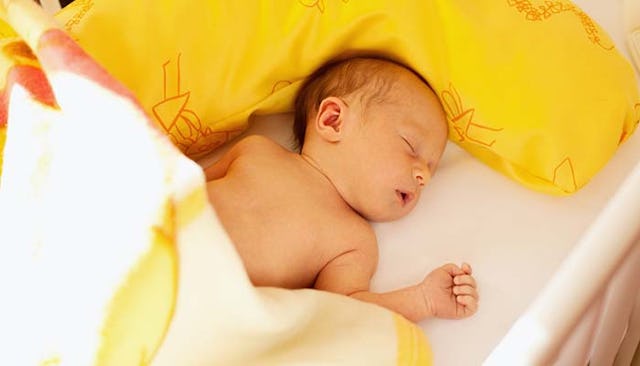Don't Put Anything In A Crib With Your Sleeping Infant

New study shows that parents are still putting infants to sleep in unsafe environments
Recently, a study was conducted that initially set out to examine new mothers’ preferred sleeping arrangements. The video study quickly turned into something that begged the question from pediatricians examining the study footage, why the hell aren’t parents listening to us?
It seems that even though parents are repeatedly warned about the dangers of putting infants to sleep with loose fitting bedding, crib bumpers, or stuffed animals in their cribs — parents still do it.
“I was surprised and alarmed,” said Dr. Ian Paul, a professor of pediatrics and public health sciences at Pennsylvania State College and one of the doctors reviewing the footage. “I’ve been a pediatrician for 18 years. I am not naive to think parents listen to everything, but [the fact that] almost every baby had loose bedding in their sleep environment was surprising to me.”
According to the study, even though parents were totally aware that they were being observed and recorded, they placed their infants in sleep environments “with established risk factors.” If they ended up moving the infants to a second location in the night, the risks got even worse.
The results are pretty unbelievable: “Among 160 one-month-olds, initially 21% were placed to sleep on nonrecommended sleep surfaces and 14% were placed nonsupine; 91% had loose/nonapproved items on their sleep surface, including bedding, bumper pads, pillows, stuffed animals, and sleep positioners. Among 151 three-month-olds, 10% were initially placed on a nonrecommended sleep surface, 18% were placed nonsupine, and 87% had potentially hazardous items on their sleep surface. By 6 months, 12% of the 147 infants initially slept on a nonrecommended surface, 33% were placed to bed nonsupine, and 93% had loose/nonrecommended items on their surface.”
One, three, and six-month olds do not care about whether or not they have a crib bumper or a stuffed animal in their crib. Why are crib bumpers still even sold? The American Academy of Pediatrics and the American SIDS Institute have both issued warnings about crib bumpers; they advise parents not to use them.
The Consumer Product Safety Commission estimates that “between 1992 and 2010 there were nearly 700 deaths involving infants 12 months and younger related to pillows and cushions placed in or near a baby’s sleep environment. Nearly half of the infant crib deaths and two-thirds of bassinet deaths reported to CPSC each year are suffocations caused by pillows, thick quilts and/or overcrowding in the baby’s sleeping space.”
The CPSC says the safest place for a baby to sleep is in a safe crib. A safe crib is one that meets the CPSC’s federal safety standards and is clear of clutter. “Clear of clutter” means no pillows, heavy blankets, quilts, stuffed animals, and no child carrying devices, recliners or sleep positioners.
Back to the study; the other jarring thing doctors found was that when parents moved fussy infants to a second location in the night, the sleeping environment became even less safe. There are ways to safely co-sleep, and the same rules that apply in the crib apply in the bed, like no blankets and pillows near baby, and baby must always be put to sleep on her back. Kelly Mom has a full list of safe co-sleeping guidelines.
“I always talk to new parents about putting their babies down to sleep on their backs in a crib that is free from blankets, toys, bumpers, or pillows,” Dr. Richard Besser, a pediatrician, told ABC News after seeing the results of the study. “I think I’ll now add a message about what you do in the middle of the night if your baby wakes up…. You never want to move them to a setting where they will be less safe.”
How much more clear do doctors have to be? Don’t put anything in a crib with your sleeping infant.
This article was originally published on